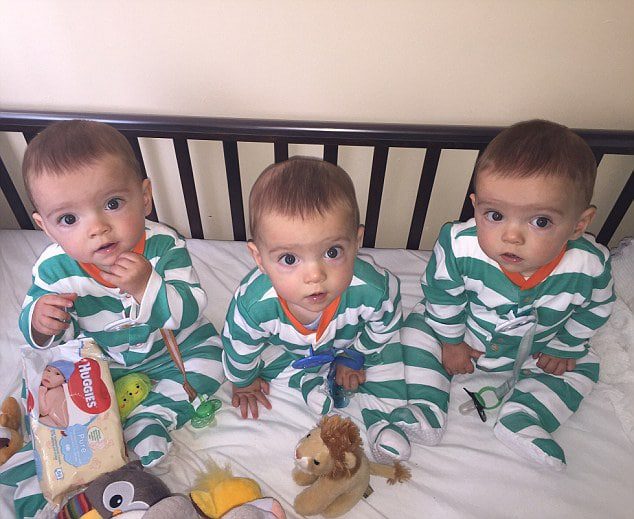For any expectant mother, learning that she was having triplets would be shocking enough.
Little Roman, Rocco, and Rohan were already doing well at home after spending six weeks in intensive care, but Becki-Jo Allen was in for another shock.
Other mothers commented on how similar they were, so she sent DNA samples for analysis. She has since learned that, despite chances of up to an amazing 200 million to one, the spontaneously conceived three are identical.
Fortunately, the triplets’ 23-year-old mother can distinguish the three of them easily thanks to distinguishing characteristics and their developing personalities.

She admitted yesterday that it was difficult to distinguish between them when they were newborns, but she never mixed them up herself.
They all have dark birthmarks between their brows, but Roman’s is a little darker than the others, and Rohan also has one on his leg.
The doctors indicated they weren’t identical when they were in the hospital, but many others have claimed they can’t tell them apart since they returned home.
According to the Multiple Births Foundation, DNA testing is typically required to determine with certainty if twins or triplets are identical, a process known as zygosity determination.
Following consultation with them, Miss Allen collected cheek swabs from Roman, Rocco, and Rohan and sent them to a lab for analysis. Earlier this month, she learned that Roman, Rocco, and Rohan are genetically identical.

They are the youngest of what are believed to be just a few sets of identical triplets who were naturally born in the UK.
I expected them to be different, so I was startled, she added. But that does explain a lot, as I’m usually the only one who can tell them apart!
Due to terrible headaches and nausea, Miss Allen of Gateacre, Liverpool, who already has a three-year-old daughter named Indiana, underwent an early ultrasound at nine weeks into her pregnancy. At that time, she learned shockingly that she was carrying triplets.
She said, “I couldn’t believe it.” “We don’t have any in the family, so I hadn’t even considered it may be twins, let alone triplets.”

The triplets were born through caesarean section at 31 weeks after weekly scans by medical professionals from Liverpool Women’s Hospital. Roman weighed 3 pounds, 6 ounces, and Rohan weighed 3 pounds, 10 ounces.
Their mother remarked that now that they are prospering at home, their personalities are beginning to emerge.
She remarked, “Rohan is the loud one; he’s always shouting.” Roman is frequently heard whining that he doesn’t want to share, whilst Rocco is typically pretty laid-back but is still capable of being feisty.
They are always scuttling around in pursuit of the same toy in an effort to reach it before their brothers do.
“Indiana adores them, she’s not at all envious, but I do feel a little terrible for her when I consider what it will be like to have three young brothers,” the speaker said.
A pack of formula lasts about two days, and the washing machine is used three times every day. The triplets use roughly 130 nappies and four packs of baby wipes each week.
She relies heavily on her sister Lauren, 17, for day-to-day assistance because their father, Liam Tierney, 28, does not reside with her.
Before having Indiana, their mother’s goal was to become a neo-natal nurse; now that she has experienced what she has, she is even more eager to realize that dream.
We’ve gotten great medical care and assistance overall, she continued. I’m just thrilled with how well they’re all doing right now.

When an egg that has been fertilized splits into two, identical triplets are produced. According to estimates, the chances of them not happening without fertility therapy range from one in 60,000 to one in 200 million.
If a membrane was shared by twins or triplets during pregnancy, they had to be identical (monozygotic). If not, only DNA testing can definitively determine whether the placentas are distinguishable from those of non-identical (dizygotic) siblings.
The Daily Mail published a story in 2014 about how Karen Gilbert of Pontypool, South Wales, had to paint her one-year-old identical triplets’ toenails a different color each morning in order to distinguish Ffion, Maddison, and Paige from one another.
Leila, Liina, and Lily Luik, identical triplets who are 30 years old, will all participate for Estonia in the marathon in this summer’s Olympics in Rio de Janeiro.

